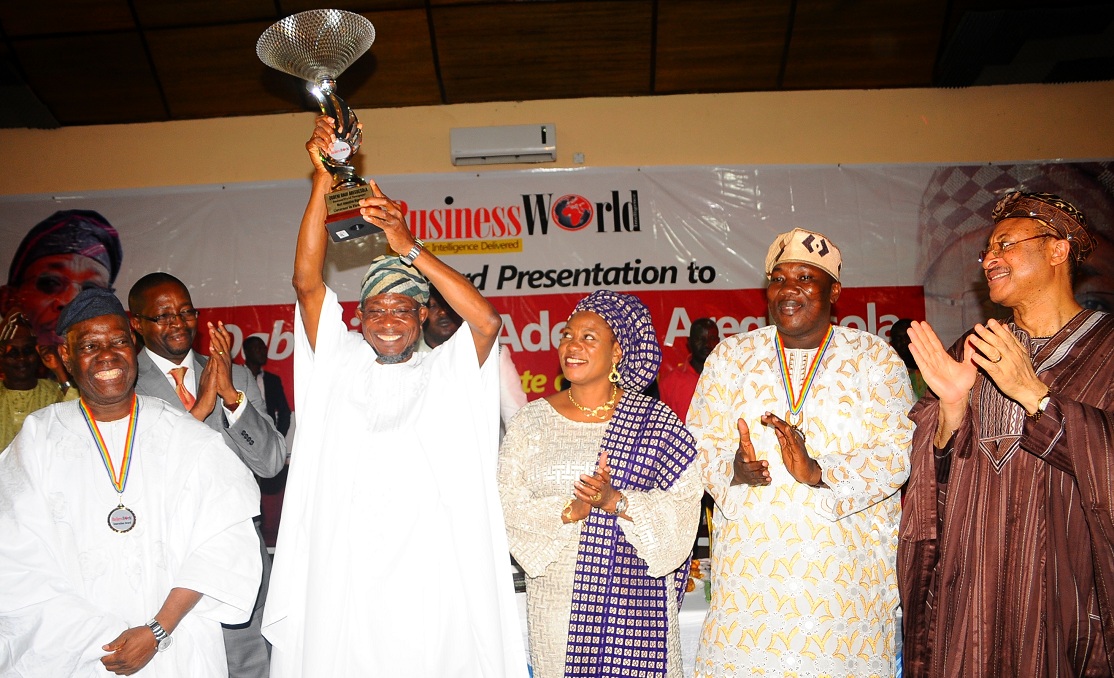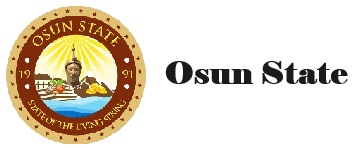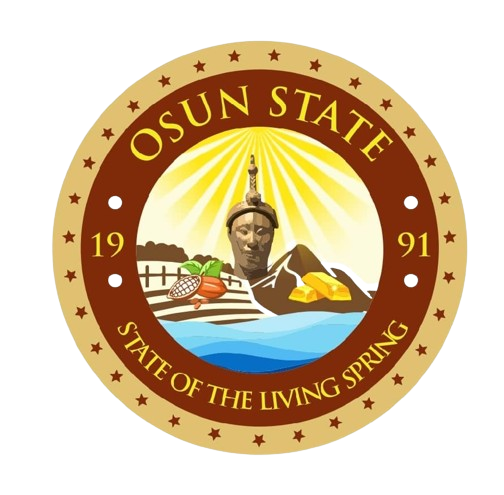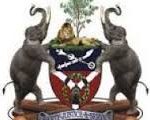
BUSINESS WORLD INTELLIGENCE REPORT: Success Stories Of The State Of Osun
 A total of 12 States were considered in the Innovation Award Initiative: two states in each of the six geo-political zones of the country were closely examined over a period of three months. It was from this effort that the State of Osun emerged as the overall winner. Some of the factors that enhanced our decisions are the turn-around projects embarked upon by Aregbesola administration which represent a tremendous improvement on what he met on ground about four years ago. Lets take a look at some of them.
A total of 12 States were considered in the Innovation Award Initiative: two states in each of the six geo-political zones of the country were closely examined over a period of three months. It was from this effort that the State of Osun emerged as the overall winner. Some of the factors that enhanced our decisions are the turn-around projects embarked upon by Aregbesola administration which represent a tremendous improvement on what he met on ground about four years ago. Lets take a look at some of them.
The Solution
The state government of Osun, along with other government units, started in the early part of the administration to implement plans that aim at developing and modernizing the state, extending the roads, expanding the network of lighting and green spaces and constructing public parks and utilities and decorative monuments. The administration’s responsibility did not stop at just implementing these projects and equipping itself with the latest technology; on the contrary, it continues to maintain the highest level of cleanliness and provide whatever is required to maintain and preserve these important utilities. Thus, Osun became a model and example of beauty and cleanliness dazzling the residents and visitors alike. Specifically, it has adopted measures to ensure a high standard of cleanliness within the key cities in the state including boosting efficiency of its internal operations, staging campaigns to promote awareness in public and individual health, enlisting the support of schools in environmental cleanliness, keeping roads clean, and giving attention to timely collection and disposal of garbage. The subject of cleanliness is the top priority facing those responsible for the cities. This subject takes a special place in view of the cities’ expansion thus attracting the people to live and work therein, forming a phenomenon of our modern time, and transforming the cleaning services into a difficult challenge. The Osun Elementary School Feeding and Health Programme now known as O-MEALS is the one of the few surviving school meal programmes in the country. It was formerly known as the Home Grown School Feeding and Health Programme (HGSFP) . This has now been restructured and enhanced by the administration of the State of Osun, to reach a larger number of students (254,000) and to empower over 3000 community caterers. The programme was initiated by the Federal Government in 2004 through the Universal Basic Education (UBE) Act. On assumption of office, the present administration undertook a comprehensive review of the inherited school feeding arrangement and came up with an overhauled and rebranded programme that was officially launched on the 30th April 2012. Implementation in primary schools is ongoing throughout the State. The key areas of improvement undertaken by the current administration are, inclusion of elementary year 4 , thereby increasing beneficiaries to 254,000, Capacity Development and Empowerment 3007 Community Caterers , backwards integration to local markets and process improvements This scheme has gained international endorsement as well. In November 2012, Partnership for Child Development (PCD) United Kingdom and the Government of the State of Osun signed the Osun Elementary School Feeding Transition Strategy Plan Document to further strengthen the programme. O-MEALS aims to reverse the very low academic performance of pupils noting that good nutrition is necessary for development of cognitive skills. The daily feeding allowance for each pupil has also been increased from N50.00 to N250.00. For effective service, a total number of 3,007 food vendors/cooks were trained and are currently employed to serve midday meals for pupils of classes 1, 2 , 3 and 4 in all primary schools in the State of Osun. For easy identification, each of the food vendors was provided with uniforms free of charge. The uniforms provided include gowns, aprons, and caps. The government of the State of Osun also facilitated provision of cooking utensils for each of the caterers at minimal cost. First Bank PLC granted a loan of N124.5 million to 123 cooperative groups of food vendors for purchasing cooking utensils. The government of the State of Osun also agreed to pay the interest accrued on the loan facility and food vendors are to repay the loan within 36 months (3 years).
The Challenge
The past governments have tried to establish effective and quality of dialogue between the citizens and the administration which have not been achieved.
The Solution
The direct dialogue that exists between the state government and the administration has made the government of Ogbeni Aregbesola to become so popular across the state. The project’s aim is to facilitate and improve the relationship between citizens and the government by simplifying the tools that citizens use to obtain information and communicate with public institutions. “Meet the Ogbeni” allows citizens to engage with the state government in an innovative manner. It seeks to advance open government by enabling a more personal channel of enquiry to government. It allows for interaction and the exchange of information with other stakeholders.
The Challenge
The Government faced the challenge of providing social assistance and support to vulnerable sections of society.
The Solution
The state government has demonstrated that it could radically transform public institutions into entities capable of providing quality service at levels comparable to those attained by their private sector counterparts. Its social policy making is aimed at promoting the generation of a new intergenerational culture. It devoted particular attention to specific demands from the different generational population groups. Providing social coverage to most sectors of society is considered as a main target and its aim is to reduce inequalities. The people are the most important asset of a government. A genuine development agenda should therefore have at its core, the welfare of people, and seek to implement a robust human capacity development programme. The Ogbeni administration passionately aligns with this governance approach and is entrenching welfarism at the centre of her development programmes. Apart from the state’s social centric programmes, other programmes like physical infrastructure programmes should also be delivered in such a way as to add social value like public services, local jobs, capacity development to pragmatically improve the socio-economic status of the people. Osun has been implementing its programmes across all society strata in this direction. Through the Osun Youth Empowerment Scheme, OYES, the state is pioneering for Nigeria, a grassroots youth empowerment scheme that has won commendations from institutions like the World Bank. For the past three years, the state has undergone a radical change in the coverage of its programmes and the increase in its benefits. This has been possible due to institutional efficacy guided to quality roles. The initiative has resulted in the efficient use of the public resources and increased benefits. The quality has been maintained, a new information system has been introduced and institutional reengineering has taken place. The initiative has resulted in the following changes:
1) Reduction in costs,
2) Transparency in the administration of resources and services,
3) Creation of a client-oriented culture (in substitution for the bureaucratic culture)
The Challenge
Public administration reforms in Osun used to be formal and did not address or respond to the needs of citizens and businesses, especially given the differences at the local level.
The Solution
Although there have been reforms in the past decade, changes in the institutional and administrative system increased the demand for further reform. For example, the state has assumed several important functions, and others have been transferred from the local governments. At the same time, the call for improving the conditions of the private sector and the market has been growing. In response to this call for reform, the State of Osun has gradually been transformed into a facilitator for cooperation and understanding between administrative institutions, as well as coordination centre for administrative innovation for citizens and businesses. Today, the state is committed to modernizing its functions through consensual methods, encouraging various government agencies to work together to reach agreement. The objective is for all stakeholders of any innovation to share goals rather than perceive them as rules imposed on them. The state government sees the development of infrastructure as key to its vision of establishing Osun as a commercial hub for the south west of Nigeria. As such, a physical infrastructure development programme to open up the state as a viable route for the transportation of goods and services between the hinterlands of Nigeria and Lagos State (Nigeria’s Business Capital) is currently being implemented. This programme entails the construction and expansion of various roads categories. These include, Boundary Highways, Inter City Roads, Township Roads , Local Government Roads and Rural Roads. These developments are currently being implemented in an integrated manner, to provide Osun with a road network system that will position it as a conduit for easy movement of goods and services from the North, (through neighboring Kwara State) towards Lagos (through neighboring Ogun State, Ijebu Igbo Axis). This stretch of Kwara – Osun -Ogun through Osun, covers over 120km road network and offers an alternative route to the very burdened Lagos-Ibadan Expressway. It is the belief of the current administration, that such an integrated road infrastructure will revive the status of Osogbo, and consequently the State , as a commercial hub for the south west region. To complement the road network system, the Ogbeni administration is developing Business Infrastructures that will cater for the opportunities that the emerging road network and commercial hub will bring. As such, the Osun-Hub(O-Hub) initiative is being implemented.
The Challenge
Reforming the educational structure to respond to the students changing needs by creating conducive Education Centres
The Solution
The state of the art educational facilities across the state has created a new structure based on the principles of clarity, flexibility, and compatibility. The reform increases students’ freedom of choice and facilitates flexibility in changing between areas of interest. The new teaching structure is expected to have positive impact on the educational sector as a whole, including the students and those employed in the field. The vision of the present administration under Ogbeni Rauf Aregbesola before coming to government was to radically increase access to Universal Basic Education in our society. This is in furtherance of the vision of the former Western Region Government under the late sage Chief Obafemi Awolowo. This is also in line with Millennium Development Goal Two (MDG 2) of achieving Universal Primary Education, which goes in consonance with Aregbesola’s programme of promoting functional education. Presently, the physical infrastructure component of these reclassification is being carried out systematically with the building of elementary, middle and high schools. The human and social component such as recruitment of teachers, provision of instructional materials, psychological and social support through value re-orientation, revival of ideals of hard work, honesty, discipline, determination, revival of Boys and Girls Clubs, calisthenics activities are simultaneously being introduced. The State Government of Osun, under Aregbesola, in its resolve to champion inspiring innovations from Africa, has undertaken a ground breaking step to utilize ICTs to concisely tackle the learning problem through the Opón Ìmò Initiative. The State, through its Opón Ìmò Technology Enhanced Learning System (OTELS), has developed a learning tool that could revolutionize learning in developing states around the world. This tool is called the Opón Ìmò, “Tablet of Knowledge”. The Opon Imo is a programme to provide senior secondary school students with free tablet computers preloaded with learning materials to prepare for school-leaving exams. These programmes were designed and are being implemented to deliver tangible and radical socio-economic value across the various demographics of the society. The comprehensive multi-sector impact of these programmes has helped Osun record dramatic improvements in human development indices.
The Challenge
How to increase efficiency and improve transparency in the Public Service by managing performance systems and service delivery arrangements to maximize their effectiveness.
The Solution
The administrations emphasized the importance of accountability, capacity building and promotion of excellence in the public sector. The Aregbesola Government has been involved with a “major reconceptualisation of the role of government”. The New Public Management Theory has been a guiding principle in helping the government to reinvent itself in the light of pressures exerted by the rapid pace of technological advances and the resulting economical, social and political impacts. National institutions need to be agile, flexible and innovative to accommodate the changes. The public service in the state took a leading role in a range of supportive initiatives to create a public service system that is robust and sustainable.



